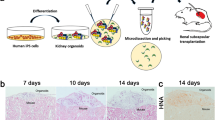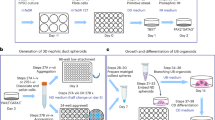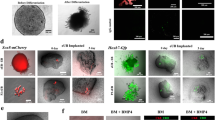Abstract
Kidney organoids are regarded as important tools with which to study the development of the normal and diseased human kidney. Since the first reports of human pluripotent stem cell-derived kidney organoids 5 years ago, kidney organoids have been successfully used to model glomerular and tubular diseases. In parallel, advances in single-cell RNA sequencing have led to identification of a variety of cell types in the organoids, and have shown these to be similar to, but more immature than, human kidney cells in vivo. Protocols for the in vitro expansion of stem cell-derived nephron progenitor cells (NPCs), as well as those for the selective induction of specific lineages, especially glomerular podocytes, have also been reported. Although most current organoids are based on the induction of NPCs, an induction protocol for ureteric buds (collecting duct precursors) has also been developed, and approaches to generate more complex kidney structures may soon be possible. Maturation of organoids is a major challenge, and more detailed analysis of the developing kidney at a single cell level is needed. Eventually, organotypic kidney structures equipped with nephrons, collecting ducts, ureters, stroma and vascular flow are required to generate transplantable kidneys; such attempts are in progress.
Key points
-
Kidney organoids are useful for modelling early onset diseases that affect glomeruli and renal tubules.
-
A better understanding of the gene expression changes that occur at a single-cell level during development of the human embryonic kidney is necessary to guide further maturation of kidney organoids; technologies such as single-cell RNA-sequencing represent powerful tools for this purpose.
-
The induction of branching ureteric buds can be achieved using a protocol that differs from that used for the induction of nephron progenitor cells.
-
Notable challenges to the use of organoids for regenerative medicine remain, including approaches to the generation of higher-order structures, organoid maturation, vascularization and single-ureter formation.
This is a preview of subscription content, access via your institution
Access options
Access Nature and 54 other Nature Portfolio journals
Get Nature+, our best-value online-access subscription
$29.99 / 30 days
cancel any time
Subscribe to this journal
Receive 12 print issues and online access
$209.00 per year
only $17.42 per issue
Buy this article
- Purchase on Springer Link
- Instant access to full article PDF
Prices may be subject to local taxes which are calculated during checkout





Similar content being viewed by others
References
Grobstein, C. Inductive interaction in the development of the mouse metanephros. J. Exp. Zool. 130, 319–339 (1955).
Auerbach, R. & Grobstein, C. Inductive interaction of embryonic tissues after dissociation and reaggregation. Exp. Cell Res. 15, 384–397 (1958).
Kobayashi, A. et al. Six2 defines and regulates a multipotent self-renewing nephron progenitor population throughout mammalian kidney development. Cell Stem Cell 3, 169–181 (2008).
Osafune, K., Takasato, M., Kispert, A., Asashima, M. & Nishinakamura, R. Identification of multipotent progenitors in the embryonic mouse kidney by a novel colony-forming assay. Development 133, 151–161 (2006).
Pichel, J. G. et al. Defects in enteric innervation and kidney development in mice lacking GDNF. Nature 382, 73–76 (1996).
Moore, M. W. et al. Renal and neuronal abnormalities in mice lacking GDNF. Nature 382, 76–79 (1996).
Sanchez, M. P. et al. Renal agenesis and the absence of enteric neurons in mice lacking GDNF. Nature 382, 70–73 (1996).
Schuchardt, A., D’Agati, V., Larsson-Blomberg, L., Costantini, F. & Pachnis, V. Defects in the kidney and enteric nervous system of mice lacking the tyrosine kinase receptor Ret. Nature 367, 380–383 (1994).
Costantini, F. & Kopan, R. Patterning a complex organ: branching morphogenesis and nephron segmentation in kidney development. Dev. Cell 18, 698–712 (2010).
Carroll, T. J., Park, J.-S., Hayashi, S., Majumdar, A. & McMahon, A. P. Wnt9b plays a central role in the regulation of mesenchymal to epithelial transitions underlying organogenesis of the mammalian urogenital system. Dev. Cell 9, 283–292 (2005).
Barak, H., Huh, S., Chen, S. & Jeanpierre, C. FGF9 and FGF20 maintain the stemness of nephron progenitors in mice and man. Dev. Cell 22, 1191–1207 (2012).
Self, M. et al. Six2 is required for suppression of nephrogenesis and progenitor renewal in the developing kidney. EMBO J. 25, 5214–5228 (2006).
Torres, M., Gómez-Pardo, E., Dressler, G. R. & Gruss, P. Pax-2 controls multiple steps of urogenital development. Development 121, 4057–4065 (1995).
Nishinakamura, R. et al. Murine homolog of SALL1 is essential for ureteric bud invasion in kidney development. Development 128, 3105–3015 (2001).
Kanda, S. et al. Sall1 maintains nephron progenitors and nascent nephrons by acting as both an activator and a repressor. J. Am. Soc. Nephrol. 25, 2584–2595 (2014).
Magella, B. et al. Cross-platform single cell analysis of kidney development shows stromal cells express Gdnf. Dev. Biol. 434, 36–47 (2017).
Rosselot, C. et al. Non-cell-autonomous retinoid signaling is crucial for renal development. Development 137, 283–292 (2010).
Bagherie-Lachidan, M. et al. Stromal Fat4 acts non-autonomously with Dachsous1/2 to restrict the nephron progenitor pool. Development 142, 2564–2573 (2015).
Mao, Y., Francis-West, P. & Irvine, K. D. A. Fat4-Dchs1 signal between stromal and cap mesenchyme cells influences nephrogenesis and ureteric bud branching. Development 142, 2574–2585 (2015).
Yu, J. et al. A Wnt7b-dependent pathway regulates the orientation of epithelial cell division and establishes the cortico-medullary axis of the mammalian kidney. Development 136, 161–171 (2009).
Mugford, J. W., Sipilä, P., McMahon, J.a & McMahon, A. P. Osr1 expression demarcates a multi-potent population of intermediate mesoderm that undergoes progressive restriction to an Osr1-dependent nephron progenitor compartment within the mammalian kidney. Dev. Biol. 324, 88–98 (2008).
Taguchi, A. et al. Redefining the in vivo origin of metanephric nephron progenitors enables generation of complex kidney structures from pluripotent stem cells. Cell Stem Cell 14, 53–67 (2014).
Taguchi, A. & Nishinakamura, R. Nephron reconstitution from pluripotent stem cells. Kidney Int. 87, 894–900 (2015).
Takasato, M. et al. Directing human embryonic stem cell differentiation towards a renal lineage generates a self-organizing kidney. Nat. Cell Biol. 16, 118–126 (2014).
Takasato, M. et al. Kidney organoids from human iPS cells contain multiple lineages and model human nephrogenesis. Nature 526, 564–568 (2015).
Morizane, R. et al. Nephron organoids derived from human pluripotent stem cells model kidney development and injury. Nat. Biotechnol. 33, 1193–1200 (2015).
Freedman, B. S. et al. Modelling kidney disease with CRISPR-mutant kidney organoids derived from human pluripotent epiblast spheroids. Nat. Commun. 6, 8715 (2015).
Przepiorski, A. et al. A simple bioreactor-based method to generate kidney organoids from pluripotent stem cells. Stem Cell Reports 11, 470–484 (2018).
Morizane, R. & Bonventre, J. V. Kidney organoids: a translational journey. Trends Mol. Med. 23, 246–263 (2017).
Little, M. H., Kumar, S. V. & Forbes, T. Recapitulating kidney development: progress and challenges. Semin. Cell Dev. Biol. 91, 153–168 (2018).
Phipson, B. et al. Evaluation of variability in human kidney organoids. Nat. Methods 16, 79–87 (2019).
Taguchi, A. & Nishinakamura, R. Higher-order kidney organogenesis from pluripotent stem cells. Cell Stem Cell 21, 730–746 (2017).
Volpato, V. et al. Reproducibility of molecular phenotypes after long-term differentiation to human iPSC-derived neurons: a multi-site omics study. Stem Cell Reports 11, 897–911 (2018).
Potter, S. S. Single-cell RNA sequencing for the study of development, physiology and disease. Nat. Rev. Nephrol. 14, 479–492 (2018).
Wu, H. et al. Comparative analysis and refinement of human PSC-derived kidney organoid differentiation with single-cell transcriptomics. Cell Stem Cell 23, 869–881 (2018).
Combes, A. N., Zappia, L., Er, P. X., Oshlack, A. & Little, M. H. Single-cell analysis reveals congruence between kidney organoids and human fetal kidney. Genome Med. 11, 3 (2019).
Lindström, N. O. et al. Conserved and divergent features of mesenchymal progenitor cell types within the cortical nephrogenic niche of the human and mouse kidney. J. Am. Soc. Nephrol. 29, 806–824 (2018).
Lindström, N. O. et al. Progressive recruitment of mesenchymal progenitors reveals a time-dependent process of cell fate acquisition in mouse and human nephrogenesis. Dev. Cell 45, 651–660 (2018).
Wang, P. et al. Dissecting the global dynamic molecular profiles of human fetal kidney development by single-cell RNA sequencing. Cell Rep. 24, 3554–3567 (2018).
Menon, R. et al. Single-cell analysis of progenitor cell dynamics and lineage specification in the human fetal kidney. Development 145, dev164038 (2018).
Miyoshi, T., Hiratsuka, K., Garcia Saiz, E. & Morizane, R. Kidney organoids in translational medicine: disease modeling and regenerative medicine. Dev. Dyn. https://doi.org/10.1002/dvdy.22 (2019).
Wu, H., Kirita, Y., Donnelly, E. L. & Humphreys, B. D. Advantages of single-nucleus over single-cell RNA sequencing of adult kidney: rare cell types and novel cell states revealed in fibrosis. J. Am. Soc. Nephrol. 30, 23–32 (2018).
Tanigawa, S. et al. Organoids from nephrotic disease-derived iPSCs identify impaired NEPHRIN localization and slit diaphragm formation in kidney podocytes. Stem Cell Reports 11, 727–740 (2018).
Hale, L. J. et al. 3D organoid-derived human glomeruli for personalised podocyte disease modelling and drug screening. Nat. Commun. 9, 5167 (2018).
Forbes, T. A. et al. Patient-iPSC-derived kidney organoids show functional validation of a ciliopathic renal phenotype and reveal underlying pathogenetic mechanisms. Am. J. Hum. Genet. 102, 816–831 (2018).
Kim, Y. K. et al. Gene-edited human kidney organoids reveal mechanisms of disease in podocyte development. Stem Cells 35, 2366–2378 (2017).
Cruz, N. M. et al. Organoid cystogenesis reveals a critical role of microenvironment in human polycystic kidney disease. Nat. Mater. 16, 1112–1119 (2017).
Pei, Y. A. ‘two-hit’ model of cystogenesis in autosomal dominant polycystic kidney disease? Trends Mol. Med. 7, 151–156 (2001).
Czerniecki, S. M. et al. High-throughput screening enhances kidney organoid differentiation from human pluripotent stem cells and enables automated multidimensional phenotyping. Cell Stem Cell 22, 929–940 (2018).
Lackland, D. T., Bendall, H. E., Osmond, C., Egan, B. M. & Barker, D. J. P. Low birth weights contribute to the high rates of early-onset chronic renal failure in the southeastern United States. Arch. Intern. Med. 160, 1472 (2000).
Karner, C. M. et al. Canonical Wnt9b signaling balances progenitor cell expansion and differentiation during kidney development. Development 138, 1247–1257 (2011).
Blank, U., Brown, A., Adams, D. C., Karolak, M. J. & Oxburgh, L. BMP7 promotes proliferation of nephron progenitor cells via a JNK-dependent mechanism. Development 136, 3557–3566 (2009).
Brown, A. et al. Role for compartmentalization in nephron progenitor differentiation. Proc. Natl Acad. Sci. USA 110, 4641–4645 (2013).
Brown, A. C., Muthukrishnan, S. D. & Oxburgh, L. A synthetic niche for nephron progenitor cells. Dev. Cell 34, 229–241 (2015).
Tanigawa, S., Taguchi, A., Sharma, N., Perantoni, A. O. & Nishinakamura, R. Selective in vitro propagation of nephron progenitors derived from embryos and pluripotent stem cells. Cell Rep. 15, 801–813 (2016).
Li, Z. et al. 3D culture supports long-term expansion of mouse and human nephrogenic progenitors. Cell Stem Cell 19, 516–529 (2016).
Chen, S. et al. Intrinsic age-dependent changes and cell-cell contacts regulate nephron progenitor lifespan. Dev. Cell 35, 49–62 (2015).
Mundel, P. et al. Rearrangements of the cytoskeleton and cell contacts induce process formation during differentiation of conditionally immortalized mouse podocyte cell lines. Exp. Cell Res. 236, 248–258 (1997).
Saleem, M. A. et al. A conditionally immortalized human podocyte cell line demonstrating nephrin and podocin expression. J. Am. Soc. Nephrol. 13, 630–638 (2002).
Chittiprol, S., Chen, P., Petrovic-Djergovic, D., Eichler, T. & Ransom, R. F. Marker expression, behaviors, and responses vary in different lines of conditionally immortalized cultured podocytes. Am. J. Physiol. Ren. Physiol. 301, F660–F671 (2011).
Song, B. et al. The directed differentiation of human iPS cells into kidney podocytes. PLOS ONE 7, e46453 (2012).
Ciampi, O. et al. Generation of functional podocytes from human induced pluripotent stem cells. Stem Cell Res. 17, 130–139 (2016).
Musah, S. et al. Mature induced-pluripotent-stem-cell-derived human podocytes reconstitute kidney glomerular-capillary-wall function on a chip. Nat. Biomed. Eng. 1, 0069 (2017).
Yoshimura, Y. et al. Manipulation of nephron-patterning signals enables selective induction of podocytes from human pluripotent stem cells. J. Am. Soc. Nephrol. 30, 304–321 (2019).
Sharmin, S. et al. Human induced pluripotent stem cell-derived podocytes mature into vascularized glomeruli upon experimental transplantation. J. Am. Soc. Nephrol. 27, 1778–1791 (2016).
Unbekandt, M. & Davies, J. A. Dissociation of embryonic kidneys followed by reaggregation allows the formation of renal tissues. Kidney Int. 77, 407–416 (2010).
Ganeva, V., Unbekandt, M. & Davies, J. A. An improved kidney dissociation and reaggregation culture system results in nephrons arranged organotypically around a single collecting duct system. Organogenesis 7, 83–87 (2011).
Kaku, Y. et al. PAX2 is dispensable for in vitro nephron formation from human induced pluripotent stem cells. Sci. Rep. 7, 4554 (2017).
Soofi, A., Levitan, I. & Dressler, G. R. Two novel EGFP insertion alleles reveal unique aspects of Pax2 function in embryonic and adult kidneys. Dev. Biol. 365, 241–250 (2012).
Naiman, N. et al. Repression of interstitial identity in nephron progenitor cells by Pax2 establishes the nephron-interstitium boundary during kidney development. Dev. Cell 41, 349–365 (2017).
Humphreys, B. D. et al. Fate tracing reveals the pericyte and not epithelial origin of myofibroblasts in kidney fibrosis. Am. J. Pathol. 176, 85–97 (2010).
Kobayashi, A. et al. Identification of a multipotent self-renewing stromal progenitor population during mammalian kidney organogenesis. Stem Cell Reports 3, 650–662 (2014).
Lemos, D. R. et al. Interleukin-1 β activates a MYC-dependent metabolic switch in kidney stromal cells necessary for progressive tubulointerstitial fibrosis. J. Am. Soc. Nephrol. 29, 1690–1705 (2018).
Combes, A. N. et al. Single cell analysis of the developing mouse kidney provides deeper insight into marker gene expression and ligand-receptor crosstalk. Development 146, dev.178673 (2019).
Yokote, S. et al. Urine excretion strategy for stem cell-generated embryonic kidneys. Proc. Natl Acad. Sci. USA 112, 12980–12985 (2015).
Serluca, F. C., Drummond, I. A. & Fishman, M. C. Endothelial signaling in kidney morphogenesis. Curr. Biol. 12, 492–497 (2002).
Homan, K. A. et al. Flow-enhanced vascularization and maturation of kidney organoids in vitro. Nat. Methods 16, 255–262 (2019).
van den Berg, C. W. et al. Renal subcapsular transplantation of PSC-derived kidney organoids induces neo-vasculogenesis and significant glomerular and tubular maturation in vivo. Stem Cell Reports 10, 751–765 (2018).
Bantounas, I. et al. Generation of functioning nephrons by implanting human pluripotent stem cell-derived kidney progenitors. Stem Cell Reports 10, 766–779 (2018).
Murakami, Y. et al. Reconstitution of the embryonic kidney identifies a donor cell contribution to the renal vasculature upon transplantation. Sci. Rep. 9, 1172 (2019).
Munro, D. A. D., Hohenstein, P. & Davies, J. A. Cycles of vascular plexus formation within the nephrogenic zone of the developing mouse kidney. Sci. Rep. 7, 3273 (2017).
Munro, D. A. D. & Davies, J. A. Vascularizing the kidney in the embryo and organoid: questioning assumptions about renal vasculogenesis. J. Am. Soc. Nephrol. 29, 1593–1595 (2018).
Goto, T. et al. Generation of pluripotent stem cell-derived mouse kidneys in Sall1-targeted anephric rats. Nat. Commun. 10, 451 (2019).
Yamaguchi, T. et al. Interspecies organogenesis generates autologous functional islets. Nature 542, 191–196 (2017).
Wu, J. et al. Interspecies chimerism with mammalian pluripotent stem cells. Cell 168, 473–486 (2017).
Yamanaka, S. et al. Generation of interspecies limited chimeric nephrons using a conditional nephron progenitor cell replacement system. Nat. Commun. 8, 1719 (2017).
Howden, S. E., Vanslambrouck, J. M., Wilson, S. B., Tan, K. S. & Little, M. H. Reporter-based fate mapping in human kidney organoids confirms nephron lineage relationships and reveals synchronous nephron formation. EMBO Rep. 20, e47483 (2019).
Acknowledgements
I thank A. Taguchi, S. Tanigawa and all the other members of the Nishinakamura laboratory for their contributions to the establishment of kidney organoid protocols and for helpful discussions.
Author information
Authors and Affiliations
Corresponding author
Ethics declarations
Competing interests
The author declares no competing interests.
Additional information
Peer review information
Nature Reviews Nephrology thanks M. Little, R. Morizane and the other, anonymous, reviewer(s) for their contribution to the peer review of this work.
Publisher’s note
Springer Nature remains neutral with regard to jurisdictional claims in published maps and institutional affiliations.
Glossary
- Induced pluripotent stem cells
-
(iPSCs). Generated by the forced expression of several transcription factors in somatic cells and can differentiate into a variety of cell types.
- Nephron progenitor cell
-
A population in the embryonic kidney that can differentiate into glomerular podocyte, Bowman’s capsule, renal tubule and loop of Henle.
- Metanephric mesenchyme
-
A population of cells accumulated around the ureteric bud tips. It contains nephron progenitors and stromal progenitors.
- Ureteric bud
-
A population of cells in the embryonic kidney that undergoes extensive branching and differentiates into collecting ducts and ureters.
- Bowman’s capsule
-
An epithelial sac surrounding the glomerulus. A structure consisting of Bowman’s capsule and a glomerulus is referred to as a renal corpuscle.
- Mesonephros
-
The embryonic kidney that develops earlier and more anteriorly than the metanephros. After forming Wolffian ducts, most parts of the mesonephros degenerate during development.
- Metanephros
-
The embryonic kidney that appears last and develops into the permanent kidney.
- Wolffian duct
-
Also known as the mesonephric duct. The epithelial duct of the mesonephros that elongates in an anterior-to-posterior direction. A portion close to the posterior end sprouts to form the ureteric bud.
- Primitive streak
-
An elongated furrow formed along the axis of gastrulation-stage embryos. Mesodermal and endodermal cells are generated from the primitive streak.
- Renal coloboma syndrome
-
A condition that manifests as kidney and eye abnormalities. It is mainly caused by PAX2 mutations.
- Angiogenesis
-
The branching of existing vessels.
- Vasculogenesis
-
The de novo formation of vessels from mesodermal precursors.
Rights and permissions
About this article
Cite this article
Nishinakamura, R. Human kidney organoids: progress and remaining challenges. Nat Rev Nephrol 15, 613–624 (2019). https://doi.org/10.1038/s41581-019-0176-x
Accepted:
Published:
Issue Date:
DOI: https://doi.org/10.1038/s41581-019-0176-x
This article is cited by
-
Application of organoids in otolaryngology: head and neck surgery
European Archives of Oto-Rhino-Laryngology (2024)
-
Towards a better understanding of diabetes mellitus using organoid models
Nature Reviews Endocrinology (2023)
-
RAAS-deficient organoids indicate delayed angiogenesis as a possible cause for autosomal recessive renal tubular dysgenesis
Nature Communications (2023)
-
Long-term viable chimeric nephrons generated from progenitor cells are a reliable model in cisplatin-induced toxicity
Communications Biology (2023)
-
On-chip construction of a fully structured scaffold-free vascularized renal tubule
Biomedical Microdevices (2023)



